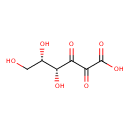|
Record Information |
|---|
| Version |
1.0 |
|---|
| Update Date |
1/22/2018 11:54:54 AM |
|---|
|
Metabolite ID | PAMDB120395 |
|---|
|
Identification |
|---|
| Name: |
2,3-dioxo-L-gulonate |
|---|
| Description: | A dioxo monocarboxylic acid anion that is the conjugate base of 2,3-diketogulonic acid, and the major species at pH 7.3. |
|---|
|
Structure |
|
|---|
| Synonyms: | - 2,3-diketo-L-gulonate
- 2,3-dioxo-L-gulonate(1−)
- 2,3-dioxo-L-gulonic
|
|---|
|
Chemical Formula: |
C6H7O7 |
|---|
| Average Molecular Weight: |
191.117 |
|---|
| Monoisotopic Molecular
Weight: |
192.02701 |
|---|
| InChI Key: |
GJQWCDSAOUMKSE-STHAYSLISA-M |
|---|
| InChI: | InChI=1S/C6H8O7/c7-1-2(8)3(9)4(10)5(11)6(12)13/h2-3,7-9H,1H2,(H,12,13)/p-1/t2-,3+/m0/s1 |
|---|
| CAS
number: |
3409-57-2 |
|---|
| IUPAC Name: | (4R,5S)-4,5,6-trihydroxy-2,3-dioxohexanoate |
|---|
|
Traditional IUPAC Name: |
diketogulonic acid |
|---|
| SMILES: | C(C(C(C(C(C([O-])=O)=O)=O)O)O)O |
|---|
|
Chemical Taxonomy |
|---|
|
Taxonomy Description | This compound belongs to the class of chemical entities known as sugar acids and derivatives. These are compounds containing a saccharide unit which bears a carboxylic acid group. |
|---|
|
Kingdom |
Chemical entities |
|---|
| Super Class | Organic compounds |
|---|
|
Class |
Organic oxygen compounds |
|---|
| Sub Class | Organooxygen compounds |
|---|
|
Direct Parent |
Sugar acids and derivatives |
|---|
| Alternative Parents |
|
|---|
| Substituents |
- Hexose monosaccharide
- Medium-chain keto acid
- Beta-keto acid
- Sugar acid
- Acyloin
- Alpha-keto acid
- Alpha-diketone
- Beta-hydroxy ketone
- Keto acid
- Monosaccharide
- Alpha-hydroxy ketone
- Ketone
- Secondary alcohol
- Carboxylic acid
- Carboxylic acid derivative
- Monocarboxylic acid or derivatives
- Polyol
- Hydrocarbon derivative
- Carbonyl group
- Alcohol
- Organic oxide
- Primary alcohol
- Aliphatic acyclic compound
|
|---|
| Molecular Framework |
Aliphatic acyclic compounds |
|---|
| External Descriptors |
|
|---|
|
Physical Properties |
|---|
| State: |
Solid |
|---|
| Charge: | -1 |
|---|
|
Melting point: |
Not Available |
|---|
| Experimental Properties: |
| Property | Value | Reference |
|---|
| Melting Point | Not Available | Not Available | | Boiling Point | Not Available | Not Available | | Water Solubility | Not Available | Not Available | | LogP | Not Available | Not Available |
|
|---|
| Predicted Properties |
|
|---|
|
Biological Properties |
|---|
| Cellular Locations: |
Not Available |
|---|
| Reactions: | |
|---|
|
Pathways: |
|
|---|
|
Spectra |
|---|
| Spectra: |
Not Available |
|---|
|
References |
|---|
| References: |
- Linster CL, Van Schaftingen E (2007)Vitamin C. Biosynthesis, recycling and degradation in mammals. The FEBS journal 274, Pubmed: 17222174
- Kärkönen A, Fry SC (2006)Effect of ascorbate and its oxidation products on H2O2 production in cell-suspension cultures of Picea abies and in the absence of cells. Journal of experimental botany 57, Pubmed: 16698813
- Shamsi FA, Partal A, Sady C, Glomb MA, Nagaraj RH (1998)Immunological evidence for methylglyoxal-derived modifications in vivo. Determination of antigenic epitopes. The Journal of biological chemistry 273, Pubmed: 9506998
|
|---|
| Synthesis Reference: |
Not Available |
|---|
| Material Safety Data Sheet (MSDS) |
Not Available |
|---|
|
Links |
|---|
| External Links: |
|
|---|


